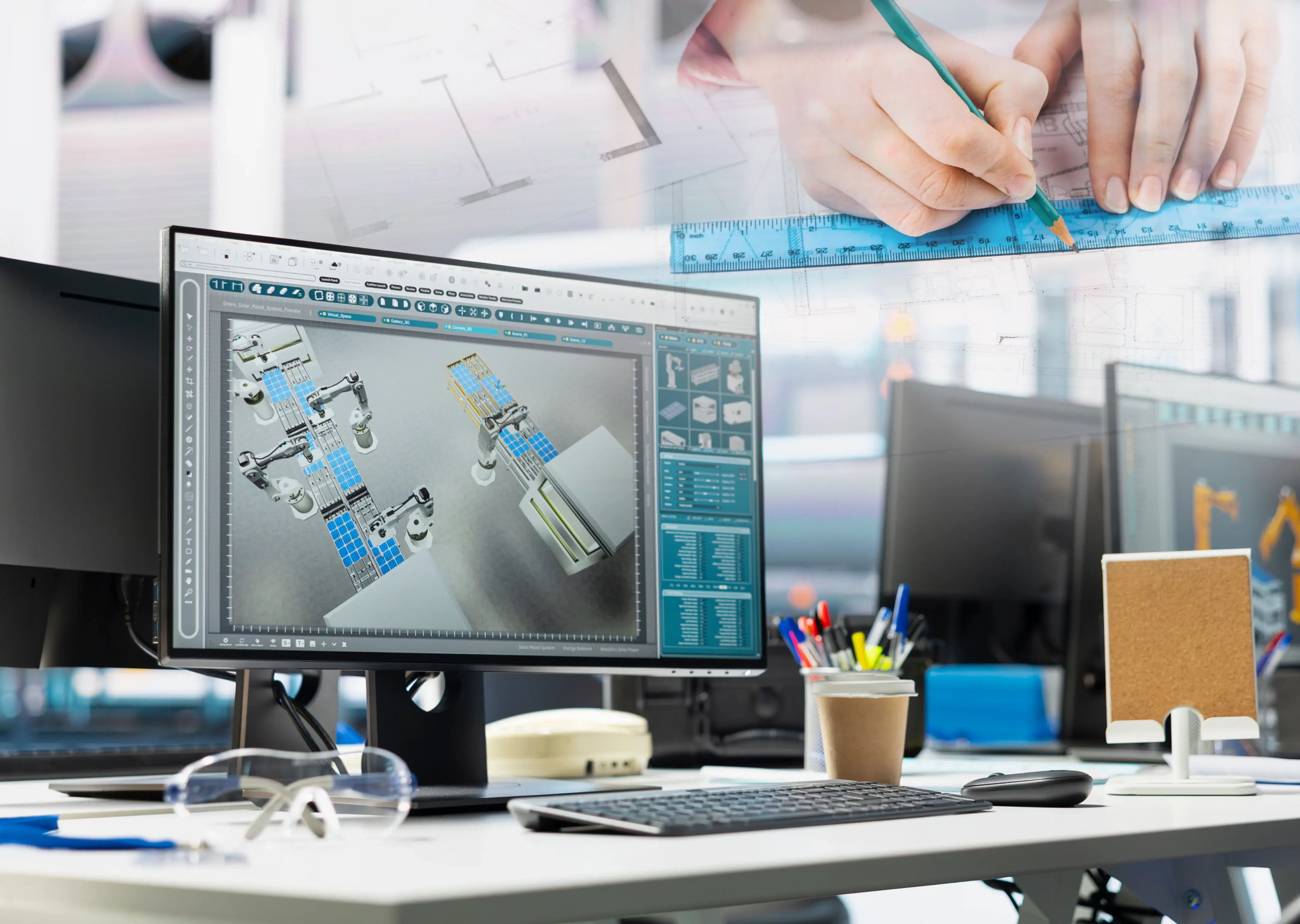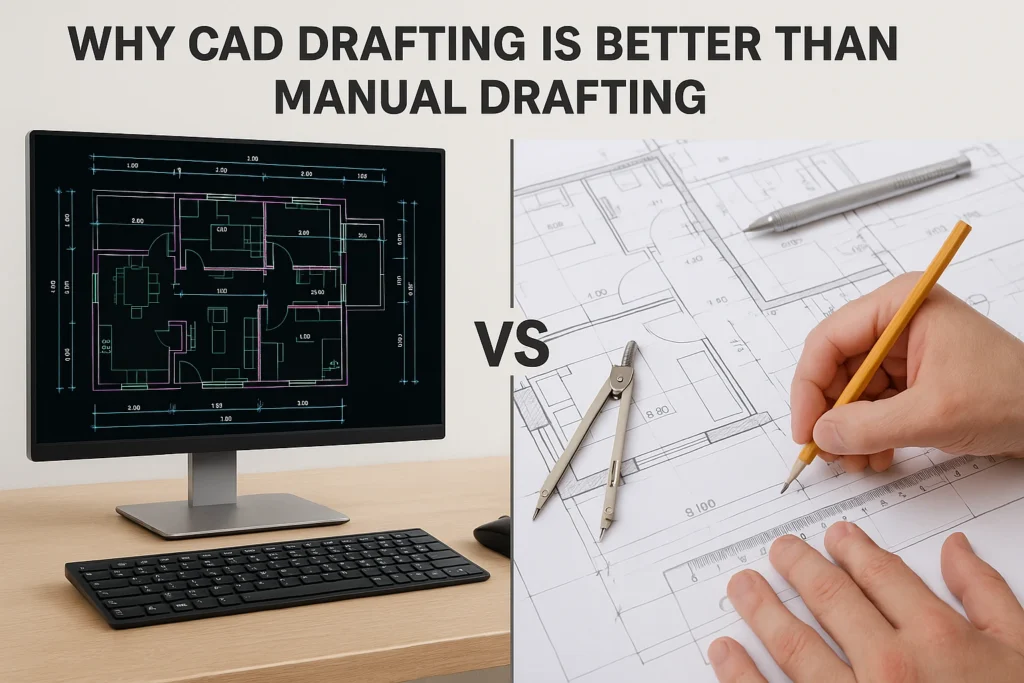
In the world of design, the shift from manual drafting to CAD drafting has revolutionized how professionals create, modify, and share their work. While traditional hand drafting has its merits, CAD drafting service offers significant advantages that make it the preferred choice for modern designers. Let’s dive into the advantages of CAD drafting over manual drafting and why it has become an essential tool in the design industry.
The Efficiency of CAD Drafting Over Manual Drafting
One of the primary reasons why CAD drafting has gained popularity is its efficiency. In manual drafting, designers must meticulously draw every line and detail by hand, which is a time-consuming process. CAD drafting, on the other hand, allows designers to create complex drawings more quickly and with greater precision. The ability to copy, paste, and modify elements in CAD software saves hours of work that would otherwise be spent redrawing by hand.
This efficiency translates into faster project completion times, which is crucial in industries where meeting deadlines is paramount. With CAD drafting, revisions and updates can be made swiftly without the need to start from scratch, making it an invaluable tool for architects, engineers, and designers who need to produce high-quality work under tight schedules.
Accuracy in CAD Drafting Versus Manual Drafting
Accuracy is another critical area where CAD drafting outperforms manual drafting. When drawing by hand, even the most skilled drafters can make small errors that might not be immediately noticeable but can lead to significant issues later on. CAD software eliminates these risks by allowing for precise measurements and alignment. The grid systems, snap features, and measurement tools built into CAD software ensure that every line and shape is drawn to exact specifications.
Furthermore, CAD drafting makes it easier to create detailed, multi-layered drawings that incorporate various elements of a project, such as electrical, plumbing, and structural plans. This level of detail is challenging to achieve with manual drafting, where each layer would need to be drawn separately and carefully aligned with the others. With CAD, these layers can be toggled on and off, making it easier to spot potential conflicts or design flaws before construction begins.
Accuracy That Manual Drafting Can’t Match
Transform your design process with professional CAD drafting services.
Advantages of Using CAD Software in Design
The versatility of CAD software is one of its most significant advantages over manual drafting. CAD software is not limited to 2D drawings; it also enables the creation of 3D models, which provide a more comprehensive view of a project. These 3D models allow designers to visualize the final product from every angle, making it easier to identify and resolve potential issues during the design phase.
Additionally, CAD software offers tools for simulating real-world conditions, such as stress tests for architectural designs or airflow analysis for HVAC systems. These simulations provide valuable insights that would be difficult, if not impossible, to achieve with manual drafting. By using CAD software, designers can test and refine their ideas in a virtual environment before committing to physical prototypes, saving both time and resources.
Why CAD Drafting is Better Than Manual Drafting?

CAD drafting offers several benefits that make it superior to manual drafting, especially in today’s fast-paced design environment. The ability to quickly produce accurate, detailed drawings is a game-changer for professionals who need to deliver high-quality work on tight deadlines. CAD software’s advanced features, such as 3D modeling and simulations, further enhance its value, allowing designers to push the boundaries of their creativity while maintaining precision and control.
Moreover, CAD drafting facilitates collaboration among team members. Multiple users can work on the same project simultaneously, sharing files and making real-time updates. Manual drafting can’t match this level of collaboration, since team members must share and update physical drawings by hand. With CAD, team members can work together more efficiently, ensuring that everyone is on the same page and that the project progresses smoothly.
CAD Drafting Efficiency Advantages
The efficiency of CAD drafting extends beyond the design phase. After completing a drawing, users can easily convert it into different formats for various purposes, such as generating blueprints, creating marketing materials, or submitting plans for regulatory approval. The digital nature of CAD drawings also makes them easier to store, retrieve, and update as needed, ensuring that all project documentation remains organized and accessible.
Another efficiency advantages of CAD drafting is its ability to automate repetitive tasks. For example, CAD software can generate a bill of materials (BOM) based on the components used in a design, saving time and reducing the risk of errors. It can also automate the creation of standard details, such as doors, windows, and fixtures, allowing designers to focus on the more creative aspects of their work.
CAD Over Manual Drafting Benefits
While manual draft requires physical tools such as pencils, rulers, and compasses, CAD drafting only requires a computer and the appropriate software. This shift from physical to digital tools has several benefits, including reduced material costs and a smaller environmental footprint. It eliminates the need for paper, ink, and other consumables associated with manual drafting, making it a more sustainable choice for environmentally conscious designers.
In addition to the cost savings, It offers greater flexibility in terms of editing and refining designs. Changes can be made quickly and easily, without the need to erase and redraw, as is the case with manual drafting. This flexibility allows designers to experiment with different ideas and iterate on their designs until they achieve the desired outcome.
Benefits of Adopting CAD Drafting
Adopting CAD drafting methods offers several long-term benefits for designers and organizations alike. For one, CAD software continues to evolve, offering new features and capabilities that keep pace with the latest advancements in technology. By staying up-to-date with the latest CAD tools, designers can maintain a competitive edge in their field and continue to produce innovative, high-quality work.
Furthermore, It is becoming increasingly important as the design industry moves towards more integrated and collaborative workflows. With the rise of Building Information Modeling (BIM) and other digital design platforms, the ability to work seamlessly with CAD software is becoming a necessity for professionals in architecture, engineering, and construction. By adopting CAD drafting methods, designers gain the skills and tools needed to meet modern project demands and deliver outstanding results.
CAD Drafting Benefits for Designers
For designers, the benefits of CAD drafting extend beyond efficiency and accuracy. CAD software allows for greater creativity and experimentation, enabling designers to explore new ideas and push the boundaries of what is possible. The ability to create and manipulate 3D models, run simulations, and visualize designs in various contexts gives designers the freedom to innovate and create truly unique and impactful work.
Additionally, CAD drafting offers opportunities for professional growth and development. As designers become more proficient with CAD software, they can take on more complex and challenging projects, expanding their skill set and enhancing their career prospects. Mastery of CAD tools is a valuable asset in today’s job market, where digital design skills are in high demand.
Manual Drafting vs. CAD Drafting: A Comparison
While manual drafting has its place in the history of design, drafts has proven to be a more efficient, accurate, and versatile method. The transition from hand-drawn to computer-generated designs represents a significant leap forward in the field. Which allowing designers to work more effectively and produce higher-quality results.
Designers still use manual drafting in certain cases, such as for artistic or historical projects, but they prefer CAD drafting for most modern designs. The advantages of CAD drafting methods, including speed, precision, flexibility, and sustainability. which make it the preferred tool for designers. Who want to stay competitive and deliver exceptional work.
Conclusion
The transition from manual drafting to CAD drafting represents a profound shift in the design world. Bringing with it a host of advantages that make it the preferred method for modern professionals. CAD drafting’s efficiency, accuracy, versatility, and collaboration tools have revolutionized how designers create, modify, and share designs.
As technology continues to advance, the benefits of CAD drafts only become more pronounced. It offering designers the tools they need to deliver high-quality work efficiently and effectively. Whether you are an architect, engineer, or designer, embracing CAD draft can enhance your workflow, boost your creativity, and ensure your projects meet the highest standards of excellence.
Ready to elevate your design projects with cutting-edge CAD drafting? Discover how our expert CAD drafting services can streamline your workflow and enhance your results. Contact us today to learn more and start transforming your designs with precision and efficiency.